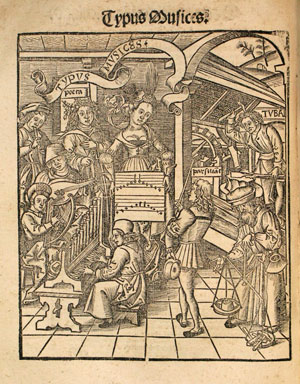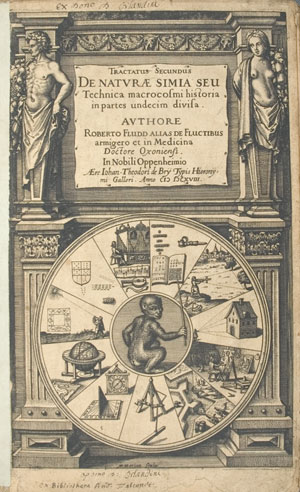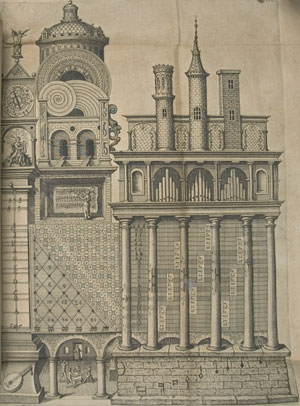Gregor Reisch (d. 1525) and Robert Fludd (1574–1637)
Gregor Reisch, Margarita philosophica (Argentine, 1512)
This popular early 16th-century encyclopaedia by Gregor Reisch exemplifies the way music had since ancient times been conceived as a part of mathematics. Arranged in sections according to the seven liberal arts, music is grouped together with three other mathematical subjects: arithmetic, geometry and astronomy (the remaining three being grammar, logic, and rhetoric).
This edition contains woodcuts with allegorical representations for each of the seven disciplines. Here we see the title page of the music section. Alongside Lady Music and practical music making, Pythagoras is shown in the foreground with a blacksmith's forge behind. According to legend, Pythagoras had discovered the mathematical basis of music when he passed by a blacksmith's shop. Hearing consonance between the sounds of hammers striking the anvil he later found that octave sounds were achieved by hammers whose weights differed by a ratio of 2:1. Whilst, in reality musical ratios apply to lengths of sounding strings rather than hammers, this tale nevertheless proved influential.
Reisch divided his music section into two parts. The first concerns the 'principles' of music, citing such authorities as Pythagoras, Plato, Boethius and al-Fārābī. Fundamental here are mathematical definitions underlying the materials of music, including scalic intervals and the causes of consonance and dissonances. The second part relates to practical music.
Robert Fludd, Utriusque cosmi maioris scilicet et minoris metaphysica, physica atque technica historia (Oppenheimii, 1617–1621)
In the 17th century Johannes Kepler, Marin Mersenne, Athanasius Kircher and Robert Fludd published key works in which music was presented as both a practical art and organising system of the universe. The Whipple Library holds part 2 of Robert Fludd's Utriusque cosmi.
This was intended as a history of the 'macrocosm and microcosm', the ancient conception that saw common patterns reproduced across the cosmos, from the level of universe (macrocosm) down to atom or even metaphysical-level (microcosm). According to Fludd's Platonic view, practical music represented but the shadow of the true and deeper music of the world and of man's place in the cosmos.
Striking illustrations predominate throughout Fludd's publications. Here we see the title page of De naturea simia (the section held by the Whipple) in which Man, the 'Ape of Nature' points to an arithmetic book, indicating that all the subjects included here are based on number. To the left of Arithmetic is Music; due to its close affinity with mathematics and mechanics, music is also discussed under several of the other subject areas.
Fludd’s Temple of Music
Here the elements of practical music are depicted along with their basis in number. Spirals of the big tower denote the movement of air caused by sound. On the left is the monochord, mathematically divided to create a musical scale. Above Pythagoras and the blacksmith's forge in the basement is a triangular graph showing the ratios of perfect and imperfect measures, and thus the relationship between rhythm and number. A second triangular graph demonstrates how Pythagorean numbers equate with actual harmonised music as shown in the musical score above it. Amongst the columns on the right may be seen the system of musical scales as used in Fludd's time.



